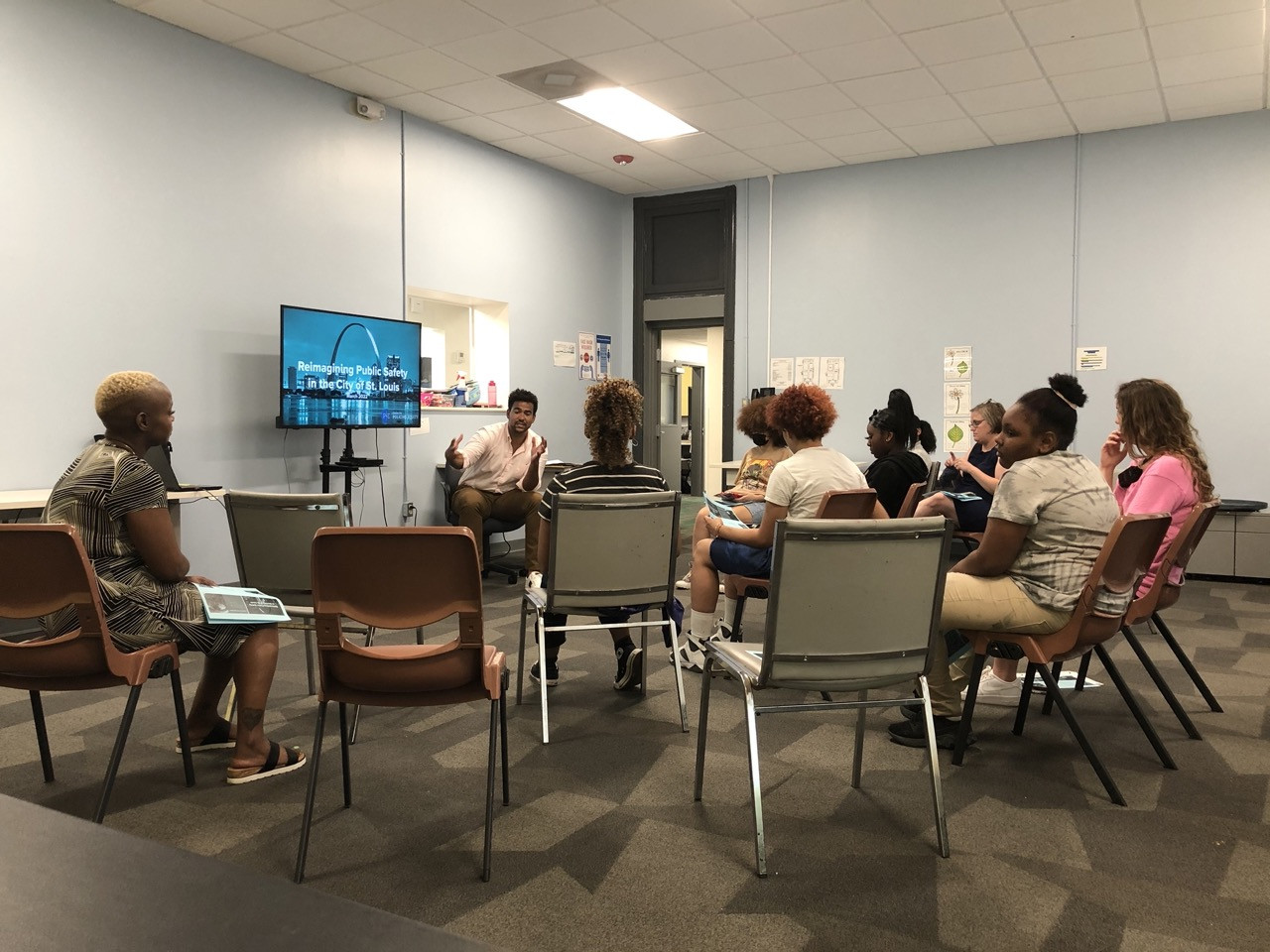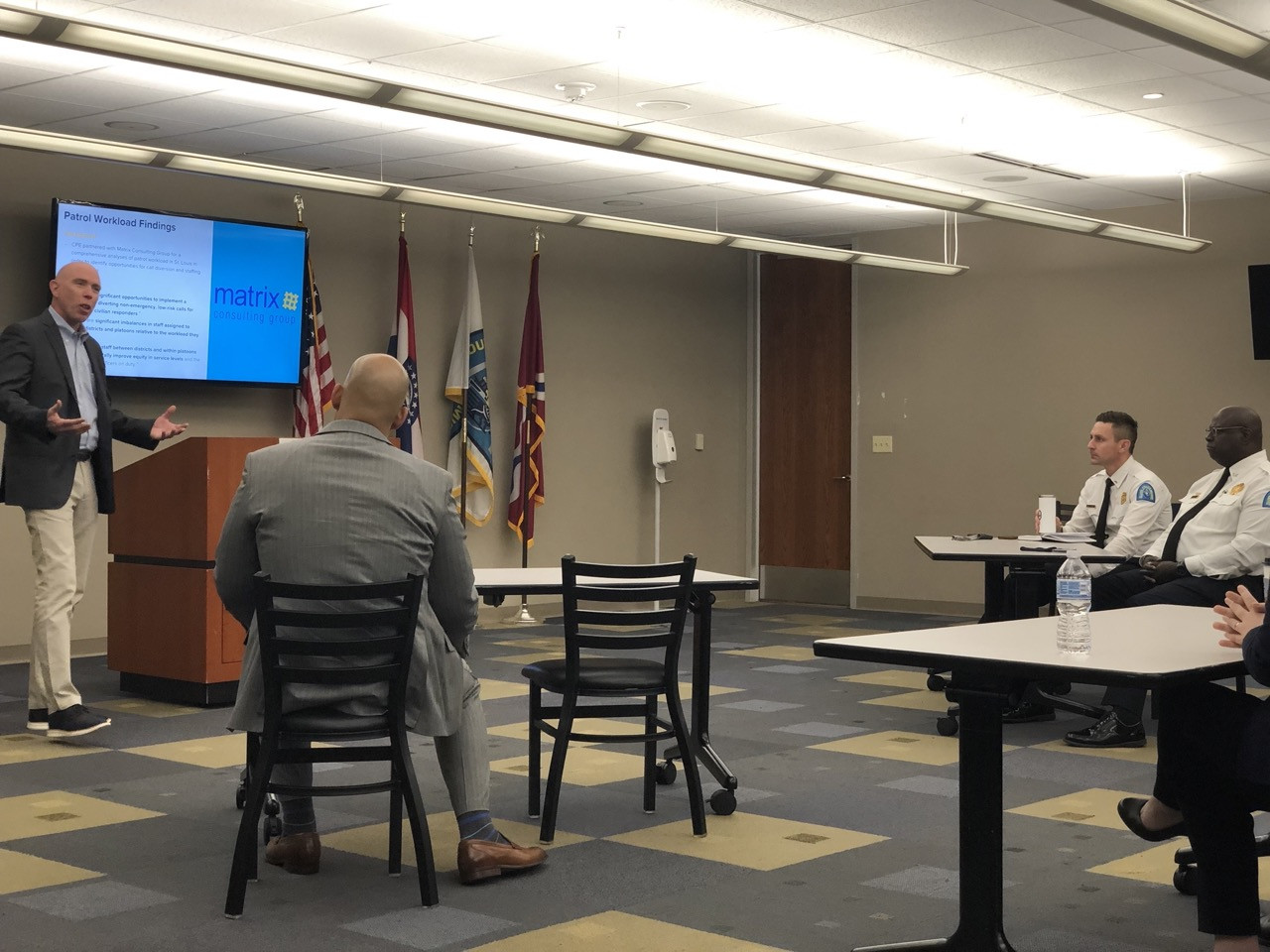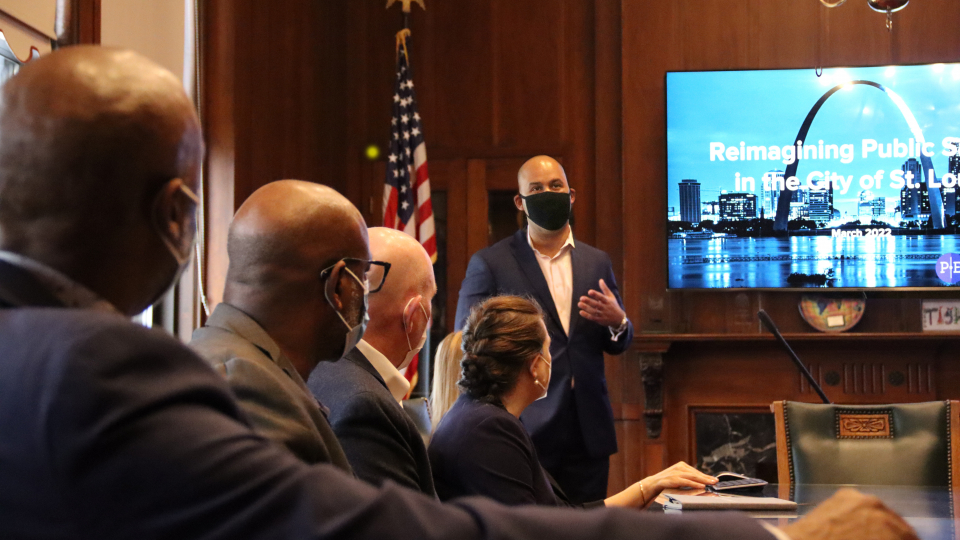"You can't talk about St. Louis without talking about Mike Brown,” says Sara Baker, Deputy Chief of Staff for St. Louis Mayor Tishaura Jones.
“Mike Brown’s murder in [St. Louis suburb] Ferguson was a catalyst for change in the region and across the country,” she says, adding that the St. Louis community was especially ready to build systems of greater accountability in policing "because we know that the status quo hasn't worked and we should try something different. There's openness to trying something new."
The 18-year-old Brown was killed by police in 2014; the subsequent uprisings shone a white-hot spotlight on the urgent need for substantive change. Efforts to redesign the area's public safety systems had long been underway, led by community members, activists, and local organizations such as the Urban League of Metropolitan St. Louis, its auxiliary the Federation of Block Units, and the St. Louis Mental Health Board. After Brown's killing, these were joined by Forward Through Ferguson and the regional collaborative St. Louis Area Violence Prevention Commission. At every level, those living with the trauma of deadly policing continued to stand up to create urgently needed solutions.
Collaboration with the Center for Policing Equity
For its part, the St. Louis Metropolitan Police Department (SLMPD) sought a partnership with the Center for Policing Equity (CPE) with the goal of producing a report concerning the extent of racial disparities in SLMPD policing. Even before that report was published in September 2021, however, the city itself reached out to CPE, seeking to collaborate on a fundamental redesign of St. Louis's public safety systems.
This second partnership entailed a months-long, data-driven analysis of those systems. In order to ground its work in community members' experience, CPE’s Triage Response Team (TRT), Community Engagement (CE), and Policy teams partnered with local residents, nonprofits, and activists as well as with the Mayor’s Office, SLMPD, and St. Louis Department of Public Safety.
“Our CE team connected with every community group they could,” TRT Vice President Hans Menos says. “Our efforts to create recommendations were done with deep respect for the expertise that comes from people’s lived experience.”

"The goal was to make sure nothing existed in isolation," says TRT Associate Program Manager Renee Van Someren, "so that our recommendations considered all of those pieces.”
CPE's teams conducted comprehensive policy reviews; collected and analyzed data from SLMPD, the city, and community organizations; and met with local leaders, activists, and others affected by burdensome policing. “People were very honest about their trauma, their difficulties, the things they’d been through," says CE Coordinator Ural Mishra, "but despite the hurt and burdens they carry, they were willing to stand up to work on those issues in their community."
After its initial examination of the data, the CPE team met with law enforcement leadership for conversations that were honest, Interim Chief Lt. Col. Michael Sack says, but not always easy.
A 28-year-veteran of SLMPD, Sack recalls that “the questions [CPE] posed to us were open-ended. They allowed us to talk about our concerns and what we think the community wants. Then they came back and talked about what they [had learned] the community wants. Those were some difficult conversations, but they were ones we needed to have.”
Policy team members also attended biweekly working group meetings with SLMPD's crisis response team, the city’s Behavioral Health Response team, the mayor’s staff, and local hospitals, to ensure that their work was aligned with initiatives that had already been launched.
A Data-Driven, Community-Centered Approach
"You often hear about disproportionate impact or bias or how some communities experience policing differently than other communities," says Serena Muhammad, deputy director of the St. Louis Mental Health Board, "CPE's ability to document that is important."
"The thing that's most significant," she goes on, "is that they had a commitment from the police department to start to look at that data and look at those numbers, and then develop plans to actually change what they're seeing for the better–because it's not enough to know something exists if you don't have a strategy to actually correct it or address it.“
Baker says CPE’s perspective on the data was critical. As SLMPD’s data analytics team addressed day-to-day priorities, she says, “CPE was able to take a step back and say, 'OK, here's some longer-term data and analysis, coupled with some outcomes,' and point to areas in which the data supported change."
“Every city's different," says TRT Senior Director Rob Kenter, "and our work is responsive to the specific needs of the city we’re in."

A Roadmap for St. Louis
Released in April 2022, Reimagining Public Safety in the City of St. Louis: A Vision for Change approaches the city's public safety systems holistically, concluding with recommendations for several key actors.
In a letter addressed to Mayor Jones and the St. Louis community that opens the report, Menos and CPE Co-founder and Senior Vice President of Justice Initiatives Tracie L. Keesee write: “To truly redesign public safety, we must let go of the assumption that police can be the primary solution to a community’s safety needs–an assumption that is neither fair to the community nor to the police. Reimagining requires a comprehensive assessment of a community’s true safety, and a reckoning with the systemic injustices at play in housing, schooling, economic opportunity, and other key safety drivers.”
The report incorporates quantitative and qualitative research, close analyses of 911 calls, response outcomes, and data on racial disparities in policing practices. It identifies specific areas of concern and concludes with actionable recommendations for law enforcement, including ending pretextual stops and other low-level violation stops; improving data collection; and instituting regular analysis of racial disparities in vehicle and pedestrian stops. The report also recommends appropriate language to ensure that SLMPD's procedures integrate best practices that are clear, specific, and enforceable.
Recommendations for the mayor’s office include strengthening the city’s response to family and intimate partner violence and engaging the community in the development and implementation of public safety strategies. Recommendations for the St. Louis Department of Public Safety include establishing a community-centered process to examine the effectiveness of the city’s Civilian Oversight Board.
Baker believes CPE’s outside perspective, “critical look” at the data, and extensive experience will help the city set priorities and “move the needle…. You can't make policy progress based on anecdotals alone."
“Getting the policies right is the foundation,” says Max Markham, Vice President of Policy & Community Engagement at CPE. “It's hard to hold people accountable if you don't have clear standards.”
An Exciting New Initiative
VPC Jessica Meyers, director of the St. Louis Area Violence Prevention Commission, was gratified to find significant overlap between her organization’s priorities and CPE’s recommendations. “Having a group like CPE amplify those recommendations is really valuable and helpful towards implementation.”
Specific areas of alignment include a 911 call diversion program that redirects certain calls to Behavioral Health Response's teams; an alternative response function for low-risk calls; engagement with community members on issues raised during the reimagining process; and the establishment of a Public Safety Collaborative (PSC).
Spearheaded by the Urban League, the PSC will employ data-informed community engagement and state-of-the-art Risk Terrain Modeling (RTM) software to identify crime hotspots, diagnose conditions conducive to crime, and take appropriate action–often non-police-based interventions as simple as repairing broken streetlights.
"With RTM you know the ‘where and why’ of crime, and [how] to address it, without the harms of over-policing,” writes the Rutgers Center on Public Security, which houses and implements the software. “RTM is proven to reduce crime, enhance public safety, and improve community relations.”
Through the Federation of Block Units, the Urban League has enlisted a group of local grassroots activists to help clarify the conditions that lead to crime and assist in addressing those conditions swiftly.
“The problem-solving won’t be anchored in a show of force, such as a mass showing of police officers," Menos says, noting that place-based, data-driven, and community-centered approaches to crime prevention "help improve public safety and democratize decision-making."
These efforts will not only serve communities better, Mayor Jones noted at a town hall held to coincide with the report's release, but will also “lighten the load” for police, by allowing them to spend their time on the kinds of calls for which they have been trained. “We're building a new muscle for other things when we can deploy the right resource to the right call."
Since the report's publication, the CE team has continued to meet with community members. “We want to get in front of as many people as possible, so they know this is happening and we can hear from them,” says Markham. “Did we miss anything? What else should we know or do? ”
Acknowledging the Past to Improve the Present
Discussing SLMPD's partnership with CPE, Sack notes that acknowledging the department's past is key to improving policing in the present.
Originally a slave-holding state, Missouri considered joining the Confederacy at the onset of the Civil War. Many White southern Missourians joined the Confederate Army, and secession-minded Governor Claiborne Jackson placed St. Louis's police department, a staunchly Unionist institution, under state control. Missouri ultimately stayed in the Union under a new governor but remained deeply divided, and it wasn't until 2013 that a statewide ballot measure returned control of the city's police to the city.
Many lingering issues have their roots in that history, Sack says, citing among them neighborhood segregation; failed experiments in mass public housing that are emblematic of racial injustice; and the discriminatory housing practice known as “redlining.”
Now, though, Sack believes real change is underway. He credits former Chief of Police John Hayden, Jr. with “getting this sucker turned around and pulling in the right direction–where integrity is important, where equitable policing is important, where people are held accountable, disciplined, or dismissed [for harmful behavior],” he says.
Sacks is quick also to credit the agency, noting that the reimaging process wouldn't have been possible without an acknowledgment among officers and department leadership "that we had created great harm with the community, mostly on the African-American community in north St. Louis." He's confident that, by reducing stress levels and allowing officers to focus on the work they're trained for, implementation of CPE’s recommendations will help the force retain, attract, and hire exceptional officers. “I think we're seeing a turning point within the agency.”
When the former chief announced his retirement, CPE also worked closely with those conducting the search for his replacement, to help identify equity-minded candidates and ensure that the department found a new chief who would support and build on the work that Hayden started.
Don't Be Afraid to Pull Back the Curtain
Baker, in the mayor's office, says that her advice to other cities would be "don't be afraid to pull back the curtain."
"Ultimately this can make better use of your resources and serve your residents better if you’re very clear on where the problems are and what you're trying to change.”
Community Resources:
- Reimagining Public Safety in the City of St. Louis: A Vision for ChangeReimagining Public Safety in the City of St. Louis: A Vision for Change Report (April 2022)
- Community Newsletter, Edition 1 (February 2023)
- Community Newsletter, Edition 2 (May 2023)
- Redesigning Public Safety in St. Louis One-Pager (October 2022)
- Redesigning Public Safety in St. Louis PSC-DICE One-Pager (April 2023)
- Redesigning Public Safety in St. Louis Elevate Conference Presentation (October 2022)
- HB702 Opposition Testimony, Matthew Graham, Data Analyst Manager (April 2023)
- HB702 Opposition Letter, Chris Burbank, Law Enforcement Strategy Consultant (March 2023)

